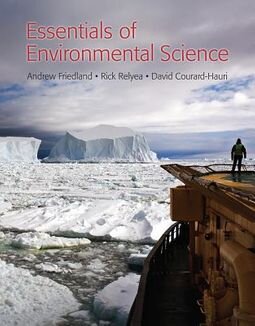2.
Andrew Friedland, Rick Relyea, and David Courar-Hauri (with Ross Jones and Susan Weisberg), Essentials of Environmental Science (New York: W. H. Freeman and Co., 2011).
In conversation with Harjo’s definition, here is how science writers Andrew Friedland, Rick Reylea, and David Courar-Hauri explain energy in the textbook Essentials of Environmental Science. What are some of the similarities and differences between these definitions of energy and Harjo’s?
Earth’s systems cannot function, and organisms cannot survive, without energy. Energy is the ability to do work, or transfer heat. Water flowing into a lake has energy because it moves and can move other objects in its path. All living systems absorb energy from their surroundings and use it to organize and reorganize molecules within their cells and to power movement … Ultimately, most energy on Earth derives from the Sun. The Sun emits electromagnetic radiation, a form of energy that includes, but is not limited to, visible light, ultraviolet light, and infrared energy, which we perceive as heat. (Friedland et al, 34)
Energy and power are not the same thing, even though we often use the words interchangeably. Energy is the ability to do work, whereas power is the rate at which work is done:
energy = power × time
power = energy ÷ time
When we talk about generating electricity, we often hear about kilowatts and kilowatt-hours. The kilo-watt (kW) is a unit of power. The kilowatt-hour (kWh) is a unit of energy. Therefore, the capacity of a turbine is given in kW because that measurement refers to the turbine’s power. Your monthly home electricity bill reports energy use—the amount of energy from electricity that you have used in your home—in kWh. (Friedland et al, 35)
